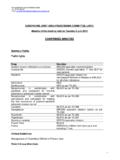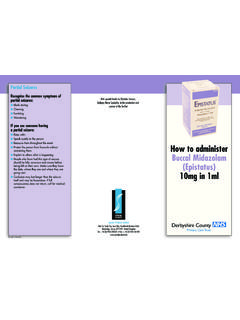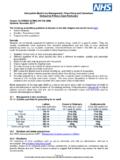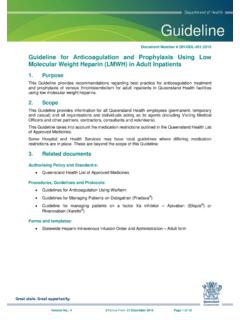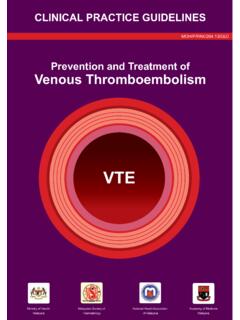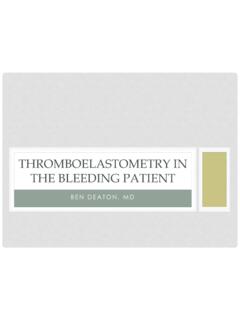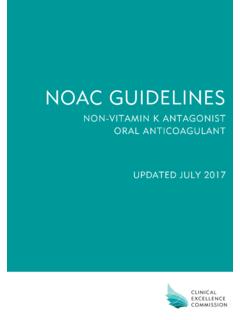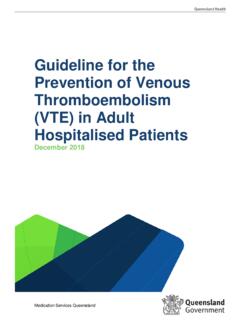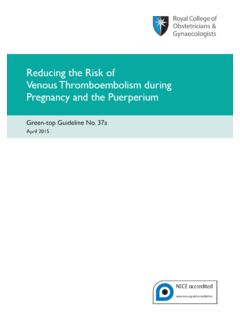Transcription of GUIDELINE ON ORAL ANTICOAGULATION WITH WARFARIN
1 GUIDELINE on oral ANTICOAGULATION Page 1 of 12 Revised: November 2019 Review Date: October 2022 GUIDELINE ON oral ANTICOAGULATION with WARFARIN This GUIDELINE is intended to be used in Derbyshire to support the Primary care led INR monitoring service commissioned in Derbyshire. Only accredited practitioners who meet the service specification and sign up to the service level agreement should provide this service. It is recommended that only 1mg strength WARFARIN tablets are used for the majority of patients. Where patients are on doses of greater than 5mg and can manage different strengths, it may be considered appropriate to use higher strength tablets.
2 Use of dosing is not recommended to avoid confusion with the 5mg. The patient should receive verbal and written information on anticoagulant therapy from the start of treatment and an induction process followed to ensure they understand the information. Each patient should be issued with an oral ANTICOAGULATION therapy (OAT) pack containing an anticoagulant record booklet (yellow booklet) which should be kept up to date. Practitioners managing oral ANTICOAGULATION with WARFARIN should meet the required competencies. WARFARIN is classified as a critical medicine as defined by the National Patient Safety Agency Rapid Response Report 18: Preventing fatalities from medication loading doses.
3 The use of loading doses of medicines can be complex and error prone. Incorrect use of loading doses or subsequent maintenance regimens may lead to severe harm or death. Particular attention should be placed on assessing concordance and checking changes in medication, food and lifestyle and the impact of these on the International Normalised Ratio (INR). Non-vitamin K antagonist oral anticoagulants (NOACs) are now available and indicated for certain conditions. Please see Derbyshire JAPC GUIDELINE : Atrial Fibrillation DERBYSHIRE JOINT AREA PRESCRIBING COMMITTEE (JAPC) GUIDELINE on oral ANTICOAGULATION Page 2 of 12 Revised: November 2019 Review Date: October 2022 Document updates Date updated Konakion MM paediatric 2mg in discontinued- brand removed and replaced with generic phytomenadione Aug 2021 CONTENTS 1.
4 Introduction Page 3 2. Indications for oral ANTICOAGULATION Page 3 3. Initiation of WARFARIN therapy Page 4 4. Maintenance Dosing Page 5 5. Monitoring Page 5 i) JAPC consensus and agreement for the management of sub-therapeutic INR Page 6 ii) Factors affecting WARFARIN sensitivity Page 6 iii) Common drug interactions with WARFARIN Page 7 6. Management of bleeding and over- ANTICOAGULATION Page 8 7. Contraindications to ANTICOAGULATION Page 9 8. Exclusions Page 9 9. Cautions Page 10 10.
5 ANTICOAGULATION in special circumstances Page 10 11. Discontinuation of WARFARIN therapy Page 10 Appendix 1: ANTICOAGULATION in Dental Surgery Page 11 Appendix 2: Resources Page 12 Appendix 3: Useful Contacts Page 12 References 1. Keeling, Baglin, Tait, Watson et al, British Committee for Standards in Haematology: guidelines on oral ANTICOAGULATION with WARFARIN fourth edition. British Journal of Haematology, 2011; 154: 311-324 2. Oates A, Jackson PR, Austin CA, Channer KS: A new regimen for starting ANTICOAGULATION in out-patients; British Journal of Clinical Pharmacology, 1998; 46:157-171 3.
6 Channer, Kevin S. Starting WARFARIN as an outpatient. British Journal of General Practice, 2002; 52:238-239 4. 23/10/ 2019 5. Joint Formulary Committee British National Formulary (BNF) 65, March 2013; accessed online via medicines complete 23/10/ 2019 6. Shetty HG, Backhouse G, Bentley DP, Routledge PA. Effective reversal of WARFARIN induced excessive ANTICOAGULATION with low dose vitamin K. thrombosis and Haemostasis, 1992; 67(1):13-15 7. Hanley JP. WARFARIN Reversal. Journal of Clinical Pathology, 2004; 57: 1132-1139 8. Makris M et al, British Committee for Standards in Haematology.
7 GUIDELINE on the management of bleeding in patients on antithrombotic agents. British Journal of Haematology, 2012; 160: 35-46. 9. McKernan A. Outpatient ANTICOAGULATION service: Management of high INR, without bleeding, due to vitamin K antagonists. February 2013. GUIDELINE reviewed by: Derbyshire Shared care and GUIDELINE Group In consultation with : Dr. Angela Mckernan consultant haematologist UHDBFT Dr. Peter Toth Consultant Hematologist CRHFT GUIDELINE on oral ANTICOAGULATION Page 3 of 12 Revised: November 2019 Review Date: October 2022 1.
8 Introduction WARFARIN has a narrow therapeutic index and regular titration of the dose against the anticoagulant effect in the blood, as assessed by the INR, is essential. The patient should be maintained within their therapeutic range, as documented in Table1. Deviation from the therapeutic range is associated with an increased risk of haemorrhage (if too high), or thrombosis and increased risk of stroke (if too low). Practitioners managing ANTICOAGULATION should have the necessary training and skills to do so. See appendix 2 for training resources.
9 2. Indications for oral ANTICOAGULATION The decision relating to diagnosis, indication for ANTICOAGULATION and INR target and range will be made in secondary care except for stroke risk reduction in atrial fibrillation patients. See AF GUIDELINE for further details. Accredited Pharmacists and nurses managing ANTICOAGULATION will not be required to make these decisions unless qualified as independent prescribers. WARFARIN may be started in out-patients if immediate ANTICOAGULATION is not necessary. Table 1. Indications for WARFARIN ; target INR, therapeutic range and duration of treatment 1 Indication Target INR & Range Duration Pulmonary embolus 3 months to long term (if unprovoked) Proximal DVT 3 months to long term (if unprovoked) Distal DVT Isolated calf vein DVT Provoked by surgery or other transient risk factors ( COC use, pregnancy, plaster cast)
10 6 weeks 3 months Recurrent events PE &/or DVT Whilst off WARFARIN or sub-therapeutic INR Whilst on WARFARIN within therapeutic range 6 months to long term Long term Non-valvular AF with CHA2DS2-VASc score 2 (see AF GUIDELINE ) CHA2DS2-VASc items CHA2DS2-VASc Score Congestive heart failure or left ventricular dysfunction 1 Hypertension 1 Age 75 2 Diabetes 1 Stroke or TIA 2 Vascular disease (prior MI, peripheral artery disease, aortic plaque) 1 Age 65-74 1 Sex category (female) 1 Long term AF secondary to valvular (mitral stenosis related)
